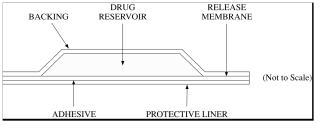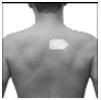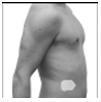FENTANYL- fentanyl patch, extended release
Bryant Ranch Prepack
----------
|
Medication Guide |
|
Fentanyl transdermal system is:
|
|
Important information about fentanyl transdermal system:
|
|
Do not use fentanyl transdermal system if you have:
|
|
Before applying fentanyl transdermal system, tell your healthcare provider if you have a history of: • head injury, seizures • liver, kidney, thyroid problems • problems urinating • pancreas or gallbladder problems • abuse of street or prescription drugs, alcohol addiction, or mental health problems. Tell your healthcare provider if you:
|
|
When using fentanyl transdermal system:
|
|
While using fentanyl transdermal system DO NOT:
|
|
The possible side effects of fentanyl transdermal system are:
Get emergency medical help if you have:
These are not all the possible side effects of fentanyl transdermal system. Call your doctor for medical advice about side effects. You may report side effects to FDA at 1-800-FDA-1088. For more information go to dailymed.nlm.nih.gov
www.actavis.com or call 1-800-272-5525 This Medication Guide has been approved by the U.S. Food and Drug Administration. Revised: September 2014 |
Fentanyl (Fen-te-nil) Transdermal System
CII
Instructions for Applying a Fentanyl Transdermal System patch
Be sure that you read, understand, and follow these Instructions for Use before you use fentanyl transdermal system. Talk to your healthcare provider or pharmacist if you have any questions.
Parts of the Fentanyl Transdermal System patch:

Before Applying Fentanyl Transdermal System
• Each fentanyl transdermal system patch is sealed in its own protective pouch. Do not remove a fentanyl transdermal system patch from the pouch until you are ready to use it.
• Do not use a fentanyl transdermal system patch if the seal is broken or the patch is cut, damaged or changed in any way.
• Fentanyl transdermal system patches are available in 4 different doses and patch sizes. Make sure you have the right dose patch or patches that have been prescribed for you.
Applying a Fentanyl Transdermal System Patch
1. Skin Areas Where the Fentanyl Transdermal System Patch May Be Applied:
For adults:
• Put the patch on the chest, back, flank (sides of the waist), or upper arm in a place where there is no hair (see Figures 1-4).
Figure 1

Figure 2

Figure 3

Figure 4

For children (and adults with mental impairment):
• Put the patch on the upper back (see Figure 2). This will lower the chances that the child will remove the patch and put it in their mouth.
For adults and children:
• Do not put a fentanyl transdermal system patch on skin that is very oily, burned, broken out, cut, irritated, or damaged in any way.
• Avoid sensitive areas or those that move around a lot. If there is hair, do not shave (shaving irritates the skin). Instead, clip hair as close to the skin as possible (see Figure 5).
Figure 5

• Talk to your healthcare provider if you have questions about skin application sites.
2. Prepare to apply a Fentanyl Transdermal System Patch:
• Choose the time of day that is best for you to apply fentanyl transdermal system. Change it at about the same time of day (3 days or 72 hours after you apply the patch) or as directed by your healthcare provider.
• Do not wear more than one fentanyl transdermal system patch at a time unless your healthcare provider tells you to do so. Before applying a new fentanyl transdermal system patch, remove the patch you have been wearing.
• Clean the skin area with clear water only. Pat skin completely dry. Do not use anything on the skin such as soaps, lotions, oils, or alcohol before the patch is applied.
3. Open the pouch: Tear the pouch along the dotted line, starting at the slit, and remove a fentanyl transdermal system patch. Each fentanyl transdermal system patch is sealed in its own protective pouch. DO NOT CUT the pouch. Do not remove the fentanyl transdermal system patch from the pouch until you are ready to use it (see Figure 6).
Figure 6

4. Peel: Peel the liner from the back of the patch and throw away. Touch the sticky side of the fentanyl transdermal system patch as little as possible (see Figure 7).
Figure 7

5. Press: Press the patch onto the chosen skin site with the palm of your hand and hold there for at least 30 seconds (see Figure 8). Make sure it sticks well, especially at the edges.
Figure 8

• Fentanyl transdermal system may not stick to all patients. You need to check the patches often to make sure that they are sticking well to the skin.
• If the patch falls off right away after applying, throw it away and put a new one on at a different skin site. See the section below called “Disposing a fentanyl transdermal system patch”.
• If you have a problem with the patch not sticking
- Apply first aid tape only to the edges of the patch.
- If you continue to have problems with the patch sticking, you may cover the patch with Bioclusive™ or Tegaderm™. These are special see-through adhesive dressings. Never cover a fentanyl transdermal system patch with any other bandage or tape. Remove the backing from the Bioclusive™ or Tegaderm™ dressing and place it carefully over the fentanyl transdermal system patch, smoothing it over the patch and your skin.
• If your patch falls off later, but before 3 days (72 hours) of use, discard it properly. See the section below “Disposing a fentanyl transdermal systempatch” Apply a new fentanyl transdermal systempatch on at a different skin site. Be sure to let your healthcare provider know that this has happened, and do not replace the new patch until 3 days (72 hours) after you put it on (or as directed by your healthcare provider).
6. Wash your hands when you have finished applying a fentanyl transdermal system patch.
7. Remove a fentanyl transdermal system patch after wearing it for 3 days (72 hours). See the section below “Disposing of fentanyl transdermal system patch”. Choose a different skin site to apply a new fentanyl transdermal system patch. Repeat Steps 2 through 6 above when applying a new fentanyl transdermal system patch.
Do not apply the new patch to the same place as the last one.
Water and fentanyl transdermal system
• You can bathe, swim or shower while you are wearing a fentanyl transdermal system patch. If the patch falls off before 3 days (72 hours) after application, dispose of it properly. See the section below “Disposing a fentanyl transdermal system patch”. Apply a new fentanyl transdermal system patch on at a different skin site. Be sure to let your healthcare provider know that this has happened, and do not replace the new patch until 3 days (72 hours) after you put it on (or as directed by your healthcare provider).
Disposing a fentanyl transdermal system patch
• Fold the used fentanyl transdermal system patch in half so that the sticky side sticks to itself (See Figure 9).
Flush the used fentanyl transdermal system down the toilet right away (See Figure 10). A used fentanyl transdermal system patch can be very dangerous for or lead to death in babies, children, pets, and adults who have not been prescribed fentanyl transdermal system.
Figure 9

Figure 10

• Throw away any fentanyl transdermal system patches that are left over from your prescription as soon as they are no longer needed. Remove the leftover patches from their protective pouch and remove the protective liner. Fold the patches in half with the sticky sides together, and flush the patches down the toilet. Do not flush the pouch or the protective liner down the toilet. These items can be thrown away in a trashcan.
This Instructions for Use has been approved by the U.S. Food and Drug Administration.
Manufactured by:
Actavis Laboratories UT, Inc.
Salt Lake City, UT 84108 USA
Distributed by:
Actavis Pharma, Inc.
Parsippany, NJ 07054 USA
Revised: September 2014
Bioclusive™ is a trademark of Ethicon, Inc.
Tegaderm™ is a trademark of 3M